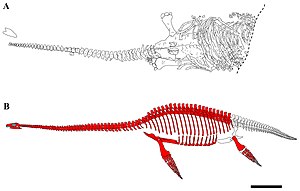Ophthalmothule
| Ophthalmothule | |
|---|---|

| |
| Quarry map (A) and reconstruction (B) of holotype skeleton | |
| Scientific classification | |
| Kingdom: | Animalia |
| Phylum: | Chordata |
| Class: | Reptilia |
| Superorder: | †Sauropterygia |
| Order: | †Plesiosauria |
| Family: | †Cryptoclididae |
| Genus: | †Ophthalmothule Roberts et al., 2020 |
| Type species | |
| †Ophthalmothule cryostea Roberts et al., 2020
| |
Opthalmothule (meaning "eye of the north"), was a cryptoclidid plesiosaur dating to the latest Volgian (around the Jurassic-Cretaceous boundary), found in the Slottsmøya Member Lagerstätte of the Agardhfjellet Formation in Spitsbergen. The type species is O. cryostea.[1]
Description
Opthalmothule was about 4.5–5.5 metres (15–18 ft) long and weighed 500 kg (1,100 lb).[1][2] It was noted to have unusually large eye sockets, which suggests a paleobiological specialization, such as deep water and/or nocturnal hunting. Along with Abyssosaurus, it is one of the youngest cryptoclidids known from boreal regions. The holotype is known from skeletal material that includes a complete cranium and a partial mandible, a complete and articulated cervical vertebrae, a set of pectoral and anterior to middle dorsal series, and the pectoral girdle and anterior humeri.[1]
References
- ^ a b c Roberts, A.J.; Druckenmiller, P.S.; Cordonnier, B.; Delsett, L.L.; Hurum, J.H. (2020). "A new plesiosaurian from the Jurassic–Cretaceous transitional interval of the Slottsmøya Member (Volgian), with insights into the cranial anatomy of cryptoclidids using computed tomography". PeerJ. 8: e8652. doi:10.7717/peerj.8652. PMC 7120097. PMID 32266112.
- ^ Paul, Gregory S. (2022). The Princeton Field Guide to Mesozoic Sea Reptiles. Princeton University Press. p. 113. ISBN 9780691193809.
Error: "Q89570051" is not a valid Wikidata entity ID.
- Articles with short description
- Short description with empty Wikidata description
- Articles with 'species' microformats
- Taxonbars desynced from Wikidata
- Taxonbar pages requiring a Wikidata item
- Taxonbars with invalid from parameters
- Taxonbars without secondary Wikidata taxon IDs
- Cryptoclidids
- Tithonian life
- Plesiosaurs of Europe
- Late Jurassic reptiles of Europe
- Jurassic Norway
- Fossils of Svalbard
- Agardhfjellet Formation
- Fossil taxa described in 2020
- Sauropterygian genera
- All stub articles
- Plesiosaur stubs







